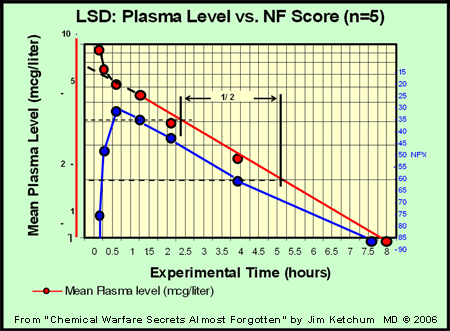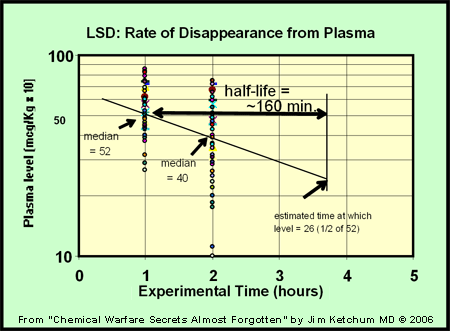Notes on the Persistence of LSD in Humans
v1.0 - May 2006
Citation: Ketchum J. "Notes on the Persistence of LSD in Humans". Erowid.org. May 2006; erowid.org/chemicals/lsd/lsd_pharmacology1.shtml
George Aghajanian, professor of psychiatry and pharmacology at Yale (and probably the world's most knowledgeable expert on LSD neuropharmacology, after 45 years of lab research and several hundred publications), first developed a reliable assay technique for measuring plasma levels of LSD in 1963, when he was a colleague of mine at Edgewood Arsenal, Maryland. He published his results in : Clinical Pharmacology and Therapeutics: Aghajanian GK, Bing OH: Persistence of lysergic acid diethylamide in the plasma of human subjects. Clin. Pharmacol. Ther. 5:611-614, 1964.
George established an approximate half-life of LSD in plasma as 175 minutes, based on serial plasma levels in 5 volunteers. I later used data from 40 additional volunteers and came up with an approximation of 160 minutes. Others have published somewhat shorter or longer half-life estimates. Research from the 1960s (and later) thus suggests that 2.5 to 3.0 hours is a fairly good consensus range for the half-life of circulating LSD in man. Persistence in the brain may be somewhat longer.
Recently, I spoke to George by phone. He has been measuring the persistence of LSD in the rat brain using brain slices. He remarked that LSD molecules do hang on to serotonin receptors (HT-2a in particular) considerably longer than he expected. They do not, however, stay indefinitely. Although in rat plasma, the half-life has previously been reported to be only 20 minutes, in the rat brain measurable levels of LSD seem to be present for a few hours. It seems logical to conclude that in man also, its duration in the brain is finite — almost certainly less than 24 hours.
The following images are from my new book "Chemical Warfare Secrets Almost Forgotten" in which I discuss the use of LSD in chemical warfare research. The first compares plasma levels of LSD with arithmetic performance of subjects given LSD. It is noteworthy that arithmetic performance scores return toward baseline in parallel with the decline of LSD in the circulating plasma. One would assume that performance and brain levels of LSD are closely correlated, so when performance is back to normal, the levels of LSD in the brain would also be close to zero.


Chart 1 "LSD: Plasma Level vs NF Score" shows a plot of LSD circulating plasma levels against math scores with five subjects. The red line is plasma levels and the blue line is math scores. Chart 2 "LSD: Rate of Disappearance from Plasma" was from my paper where I replicated Aghajanian's methodology to look at the half-life of LSD in the circulating plasma, with a total of 40 subjects.
I hope this provides a reasonably definitive answer to the question as to whether LSD stays in the body "forever".
George established an approximate half-life of LSD in plasma as 175 minutes, based on serial plasma levels in 5 volunteers. I later used data from 40 additional volunteers and came up with an approximation of 160 minutes. Others have published somewhat shorter or longer half-life estimates. Research from the 1960s (and later) thus suggests that 2.5 to 3.0 hours is a fairly good consensus range for the half-life of circulating LSD in man. Persistence in the brain may be somewhat longer.
Recently, I spoke to George by phone. He has been measuring the persistence of LSD in the rat brain using brain slices. He remarked that LSD molecules do hang on to serotonin receptors (HT-2a in particular) considerably longer than he expected. They do not, however, stay indefinitely. Although in rat plasma, the half-life has previously been reported to be only 20 minutes, in the rat brain measurable levels of LSD seem to be present for a few hours. It seems logical to conclude that in man also, its duration in the brain is finite — almost certainly less than 24 hours.
The following images are from my new book "Chemical Warfare Secrets Almost Forgotten" in which I discuss the use of LSD in chemical warfare research. The first compares plasma levels of LSD with arithmetic performance of subjects given LSD. It is noteworthy that arithmetic performance scores return toward baseline in parallel with the decline of LSD in the circulating plasma. One would assume that performance and brain levels of LSD are closely correlated, so when performance is back to normal, the levels of LSD in the brain would also be close to zero.


Chart 1 "LSD: Plasma Level vs NF Score" shows a plot of LSD circulating plasma levels against math scores with five subjects. The red line is plasma levels and the blue line is math scores. Chart 2 "LSD: Rate of Disappearance from Plasma" was from my paper where I replicated Aghajanian's methodology to look at the half-life of LSD in the circulating plasma, with a total of 40 subjects.
Bio Brief:
Jim Ketchum is a researcher and author of the book Chemical Warfare Secrets Almost Forgotten, AuthorHouse Publications, 2006.
Jim Ketchum is a researcher and author of the book Chemical Warfare Secrets Almost Forgotten, AuthorHouse Publications, 2006.


